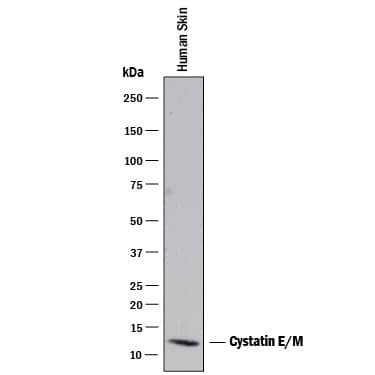Human Cystatin E/M Antibody
R&D Systems, part of Bio-Techne | Catalog # AF1286


Key Product Details
Species Reactivity
Validated:
Cited:
Applications
Validated:
Cited:
Label
Antibody Source
Product Specifications
Immunogen
Arg29-Met149
Accession # Q15828
Specificity
Clonality
Host
Isotype
Scientific Data Images for Human Cystatin E/M Antibody
Detection of Human Cystatin E/M by Western Blot.
Western blot shows lysates of human skin tissue. PVDF membrane was probed with 1 µg/mL of Goat Anti-Human Cystatin E/M Antigen Affinity-purified Polyclonal Antibody (Catalog # AF1286) followed by HRP-conjugated Anti-Goat IgG Secondary Antibody (Catalog # HAF017). A specific band was detected for Cystatin E/M at approximately 13 kDa (as indicated). This experiment was conducted under reducing conditions and using Immunoblot Buffer Group 1.Detection of Human Cystatin E/M by Simple WesternTM.
Simple Western lane view shows lysates of human skin tissue, loaded at 0.2 mg/mL. A specific band was detected for Cystatin E/M at approximately 13 kDa (as indicated) using 50 µg/mL of Goat Anti-Human Cystatin E/M Antigen Affinity-purified Polyclonal Antibody (Catalog # AF1286) followed by 1:50 dilution of HRP-conjugated Anti-Goat IgG Secondary Antibody (Catalog # HAF109). This experiment was conducted under reducing conditions and using the 12-230 kDa separation system. Non-specific interaction with the 230 kDa Simple Western standard may be seen with this antibody.Detection of Human Cystatin E/M/CST6 by Western Blot
Cystatin E/M and C secretions from various cell lines: Common laboratory non-melanoma and established laboratory melanoma cell lines (top), and primary and metastatic melanoma cell lines established from patients, as well as skin control (bottom). (A) Equal amounts of serum free media were collected from 5 × 105 cells 48 h after changing from ordinary growth media and secreted proteins were concentrated by TCA-precipitation and subjected to SDS-PAGE and immunoblotting. The filters were stained with a cystatin E/M-specific (upper panels) or a cystatin C-specific (lower panel) antibody, respectively. (B) Inhibitory activity against legumain was measured in the conditioned media as residual legumain activity. A partially purified legumain fraction from rat kidney was mixed with conditioned media and the ability to cleave the substrate Z-Ala-Ala-Asn-NHMec was measured by fluorometry. Control bar (100%) represents activity in the rat legumain fraction without addition of conditioned media. Image collected and cropped by CiteAb from the following open publication (https://pubmed.ncbi.nlm.nih.gov/20074384), licensed under a CC-BY license. Not internally tested by R&D Systems.Applications for Human Cystatin E/M Antibody
Immunohistochemistry
Sample: Immersion fixed paraffin-embedded sections of human skin
Immunoprecipitation
Sample: Conditioned cell culture medium spiked with Recombinant Human Cystatin E/M (Catalog # 1286-PI), see our available Western blot detection antibodies
Simple Western
Sample: Human skin tissue
Western Blot
Sample: Human skin tissue
Reviewed Applications
Read 1 review rated 5 using AF1286 in the following applications:
Formulation, Preparation, and Storage
Purification
Reconstitution
Formulation
Shipping
Stability & Storage
- 12 months from date of receipt, -20 to -70 °C as supplied.
- 1 month, 2 to 8 °C under sterile conditions after reconstitution.
- 6 months, -20 to -70 °C under sterile conditions after reconstitution.
Background: Cystatin E/M
Cystatin E/M encoded by the CST6 gene is a member of family 2 of the cystatin superfamily (1, 2). It inhibits papain and cathepsin B, two of the cysteine proteases. Its mRNA was found in many tissues by the two groups who did initial cloning (1, 2). However, its protein was found only in skin and sweat glands by a third group (3). In addition to being a cysteine protease inhibitor, cystatin E/M is also a substrate for transglutaminases (3). It is required for viability and for correct formation of cornified layers in the epidermis and hair follicles, as ichq mice, with a null mutation in the cystatin E/M gene, have defects in epidermal cornification and die between 5 and 12 days of age (4). Cystatin E/M expression and function may not be limited to cutaneous epithelia. For example, it is found in rat brain and is induced during neuronal cell differentiation (5).
References
- Sotiropoulou, G. et al. (1997) J. Biol. Chem. 272:903.
- Ni, J. et al. (1997) J. Biol. Chem. 272:10853.
- Zeeuwen, P.L. et al. (2001) J. Invest. Dermatol. 116:693.
- Zeeuwen, P.L. et al. (2002) Hum. Mol. Genet. 11:2867.
- Hong, J. et al. (2002) J. Neurochem. 81:922.
Alternate Names
Gene Symbol
UniProt
Additional Cystatin E/M Products
Product Documents for Human Cystatin E/M Antibody
Product Specific Notices for Human Cystatin E/M Antibody
For research use only


